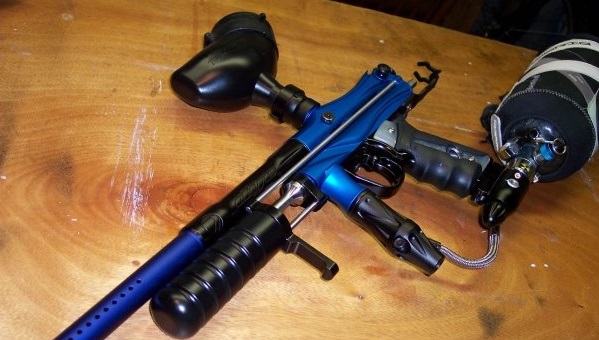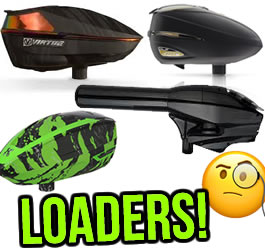Are you ready to dive into the world of paintball? Well, hold onto your goggles because we’re about to explore the different types of paintball hoppers! Paintball hoppers are the devices that hold the paintballs and feed them into your marker. They come in a variety of styles and offer different features to enhance your gameplay. So, let’s jump right in and discover what makes each type of paintball hopper unique!
First up, we have the gravity-fed hoppers. These are the simplest and most common types of hopper you’ll come across. Just like its name suggests, gravity-fed hoppers rely on good old gravity to feed the paintballs into your marker. With no fancy machinery or batteries required, these hoppers are reliable and easy to use. They are a great option for beginners looking to get started in the game without breaking the bank.
Next on our list are the electronic hoppers. These hoppers are a step up from the gravity-fed ones and offer an extra oomph to your paintball experience. Equipped with batteries and electronic components, they can feed paintballs at a faster rate, ensuring quick and consistent shots. Electronic hoppers also come with features like anti-jam technology and adjustable feed rates, giving you more control over your gameplay.
Last but not least, we have the force-fed hoppers. These hoppers take the game to a whole new level with their advanced feeding mechanisms. Using a combination of motors, paddles, and sensors, force-fed hoppers offer lightning-fast feed rates and can handle high rates of fire. They are a popular choice among competitive players who demand maximum performance from their equipment. With their superior feeding capabilities, force-fed hoppers ensure that you’ll always have paintballs ready to go when you need them.
So, whether you’re just starting out or looking to up your game, choosing the right paintball hopper is crucial. Each type has its own advantages and considerations, so make sure to pick the one that suits your playing style and needs. Stay tuned as we dive deeper into each type of hopper and explore their features and benefits. It’s time to gear up and unleash the paintball fun!
Different Types of Paintball Hoppers: A Comprehensive Guide
Paintball is a thrilling sport that requires the right equipment to excel. One crucial piece of gear every player needs is a paintball hopper, also known as a loader. Paintball hoppers come in various types, each with its unique features and benefits. In this article, we will explore the different types of paintball hoppers and help you choose the one that best suits your playing style and needs.
Main Topic 1: Gravity-Fed Paintball Hoppers
Gravity-fed paintball hoppers are the most basic type and are commonly used by beginners or recreational players. These hoppers rely on gravity to feed paintballs into the marker. As you shoot, the paintballs simply roll down into the marker, where they are propelled by the air pressure. Gravity-fed hoppers are simple, reliable, and easy to use.
However, they have some limitations. Due to their reliance on gravity, they may have difficulty feeding paintballs rapidly during fast-paced games. They also have a limited capacity, typically holding around 200 paintballs. If you’re a beginner or casual player, a gravity-fed hopper may be suitable for you. It’s affordable, low-maintenance, and gets the job done without any fancy features.
On the other hand, if you’re a more serious player or participate in competitive games, you may want to consider other types of hoppers that offer faster feeding rates and larger capacity.
Main Topic 2: Electronic Paintball Hoppers
Electronic paintball hoppers are the go-to choice for most advanced players and professionals. These hoppers utilize electronic mechanisms to feed paintballs at high rates, allowing for rapid firing and increased accuracy. They feature motors and sensors that detect the movement of the paintballs and feed them into the marker precisely when needed.
One of the key advantages of electronic hoppers is their ability to feed paintballs consistently, regardless of how fast you shoot. They can keep up with the fastest firing rates, ensuring a steady supply of paintballs to your marker. Most electronic hoppers also have a large capacity, some holding up to 250 or more paintballs.
Electronic hoppers often come with additional features such as adjustable feed rates, anti-jam technology, and battery indicators. These advanced functionalities enhance performance and reliability on the field. It’s important to note that electronic hoppers are pricier than gravity-fed hoppers, but they offer superior performance and are worth the investment for serious players.
Benefits of Gravity-Fed Paintball Hoppers
While gravity-fed hoppers may not have the advanced features of electronic hoppers, they still have their advantages. First and foremost, they are affordable and budget-friendly, making them accessible to all players. They are also highly reliable as they have no moving parts or electronic components that can malfunction.
Furthermore, gravity-fed hoppers are extremely lightweight, which can be beneficial for players who prefer a lighter setup. Their simplicity also means they require minimal maintenance and are less likely to experience technical issues on the field.
Overall, if you’re a beginner or a recreational player looking to get into paintball without breaking the bank, a gravity-fed hopper is a solid choice that will get the job done.
Benefits of Electronic Paintball Hoppers
Electronic paintball hoppers offer unparalleled performance and capabilities, making them the preferred choice for serious players. Their ability to feed paintballs consistently and rapidly ensures a constant supply of ammo during intense gameplay, giving you a significant advantage on the field.
Electronic hoppers also come with various programmable settings, allowing you to fine-tune the feed rate and adapt to different shooting styles. Some models even have advanced features like anti-jam technology, which prevent paintballs from getting stuck or breaking inside the hopper.
Another advantage of electronic hoppers is their larger capacity, which allows you to carry more paintballs without constantly reloading. This can be especially beneficial in longer games or scenarios that require sustained fire.
Choosing the Right Paintball Hopper for You
When it comes to selecting a paintball hopper, it ultimately depends on your playing style, skill level, and budget. If you’re just starting and want a basic, no-frills option, a gravity-fed hopper is a suitable choice. On the other hand, if you’re serious about paintball and want top-of-the-line performance, an electronic hopper is the way to go.
Consider your needs, preferences, and the level of competition you plan to engage in. It’s also helpful to read reviews, seek advice from experienced players, and try out different hoppers if possible. Ultimately, the right hopper will enhance your gameplay and make your paintball experience even more enjoyable.
Main Topic 3: Force-Feed Paintball Hoppers
Force-feed paintball hoppers, also known as agitating hoppers, offer a middle ground between gravity-fed and electronic hoppers. These hoppers use a combination of agitation and some mechanical assistance to feed paintballs into the marker.
Inside a force-feed hopper, there are agitating paddles or arms that keep the paintballs in constant motion. This ensures that the paintballs stay loose and prevent jams when shooting rapidly. The mechanical assistance helps push the paintballs into the marker, allowing for a faster feeding rate compared to gravity-fed hoppers.
Force-feed hoppers strike a balance between affordability and performance. They are typically less expensive than electronic hoppers but offer superior feeding rates and anti-jam capabilities compared to gravity-fed options. They are a popular choice among intermediate players who want reliable performance without the higher cost of electronic hoppers.
Tips for Choosing a Force-Feed Paintball Hopper
When considering a force-feed paintball hopper, there are a few factors to keep in mind. First, look for a hopper with adjustable settings, allowing you to control the feed rate to match your shooting style and marker capabilities. This flexibility ensures optimal performance and minimizes jams.
Another important aspect is the durability and construction of the hopper. Look for models made from sturdy materials that can withstand the rigors of paintball gameplay. It’s also worth considering the weight and size of the hopper, as these factors can impact your maneuverability and comfort on the field.
Lastly, check the capacity of the hopper and ensure it meets your needs. Consider how long your typical games last and whether you prefer to carry extra paintballs or reload more frequently. A larger capacity may be beneficial for longer games, while a smaller one can encourage more strategic and conservative play.
Conclusion and Final Tips
In conclusion, choosing the right paintball hopper is essential for a satisfying gameplay experience. Whether you opt for a gravity-fed, electronic, or force-feed hopper, each type has its advantages and considerations. Gravity-fed hoppers are affordable and reliable, making them suitable for beginners and recreational players. Electronic hoppers offer advanced features and superior performance, ideal for serious players and professionals. Force-feed hoppers strike a balance between affordability and performance, making them a popular choice for intermediate players.
Consider your playing style, skill level, and budget when selecting a paintball hopper. It’s important to choose one that suits your needs and enhances your gameplay. Keep in mind features like feed rate, capacity, durability, and adjustability when making your decision. By choosing the right hopper for you, you can take your paintball skills to the next level and dominate on the field.
Key Takeaways: Different types of paintball hoppers
- Gravity-fed hoppers: These hoppers rely on gravity to feed the paintballs into the marker.
- Electronic hoppers: These hoppers use batteries and a motor to agitate and feed the paintballs quickly.
- Force-fed hoppers: These hoppers use a combination of gravity and gentle agitation to feed paintballs consistently.
- Magazine-fed hoppers: These hoppers mimic real firearm magazines and hold a limited number of paintballs.
- Low-profile hoppers: These hoppers sit closer to the marker, providing a smaller profile and easier aiming.
Frequently Asked Questions
When it comes to paintball hoppers, there are different types available to suit different player preferences and needs. Whether you’re a beginner or a seasoned pro, understanding the different types of paintball hoppers can help enhance your gameplay. Here are some commonly asked questions about paintball hoppers:
1. What is a gravity-fed paintball hopper?
A gravity-fed paintball hopper is the most basic type of hopper. It relies on gravity to feed paintballs into the marker. These hoppers are simple to use and typically have a lower ball capacity. They are ideal for beginners or recreational players who don’t need a high rate of fire.
However, gravity-fed hoppers may not be suitable for fast-paced or competitive gameplay as they can’t feed paintballs quickly enough. If you’re looking to upgrade your hopper for faster shooting, consider other types such as electronic or force-fed hoppers.
2. What are electronic paintball hoppers?
Electronic paintball hoppers, also known as “electro” hoppers, use battery-powered motors to feed paintballs into the marker. These hoppers are designed to increase the rate of fire and ensure consistent feeding, even during rapid firing.
Electronic hoppers often have features like adjustable feed rates, anti-jam technology, and battery level indicators. They are widely used by experienced players and in competitive settings where speed and performance are crucial. However, they can be more expensive than other types of hoppers.
3. What are force-fed paintball hoppers?
Force-fed paintball hoppers use agitating paddles or propellers to force paintballs into the marker. These hoppers provide a constant and reliable feed, ensuring smooth operation even at high rates of fire. They are commonly used in competitive paintball where speed and consistency are essential.
Force-fed hoppers come in various designs, including the traditional “halo-style” hoppers or the more compact “rotor-style” hoppers. They are reliable, efficient, and are capable of accommodating larger ball capacities, making them suitable for intense gameplay scenarios.
4. What is a low-profile paintball hopper?
A low-profile paintball hopper refers to a hopper design that sits closer to the marker, reducing its overall height and profile. These hoppers are popular among players who prefer a more streamlined setup or those who use smaller markers.
Low-profile hoppers are typically gravity-fed and offer a smaller ball capacity. They provide a more compact and lightweight option for players who value maneuverability and agility on the field. They may not have the same high feed rates as electronic or force-fed hoppers, but they offer a more stealthy approach.
5. Are there customizable paintball hoppers available?
Yes, there are customizable paintball hoppers available in the market. Some hoppers allow you to personalize the look of the shell by adding custom colors, graphics, or even swapping out shell components. This allows players to create a unique look for their gear and stand out on the field.
In addition to customization options, some hoppers also offer adjustable settings for feed rates, anti-jam mechanisms, and various other features. These customizable hoppers provide players with more control over their hopper’s performance and allow them to fine-tune it to their specific playing style.
Gravity-Fed vs. Electronic Hoppers | Paintball
Summary
Paintball hoppers come in different types, each with its own advantages and limitations. Gravity-fed hoppers are simple to use but can cause feed issues. Agitating hoppers use spinning paddles to keep the paintballs feeding smoothly. Finally, force-fed hoppers use motors to push paintballs into the gun reliably and quickly.
When choosing a hopper, it’s important to consider factors like budget, playing style, and the type of paintball gun being used. Ultimately, it’s about finding the right balance between speed, reliability, and convenience for the best paintball experience.





